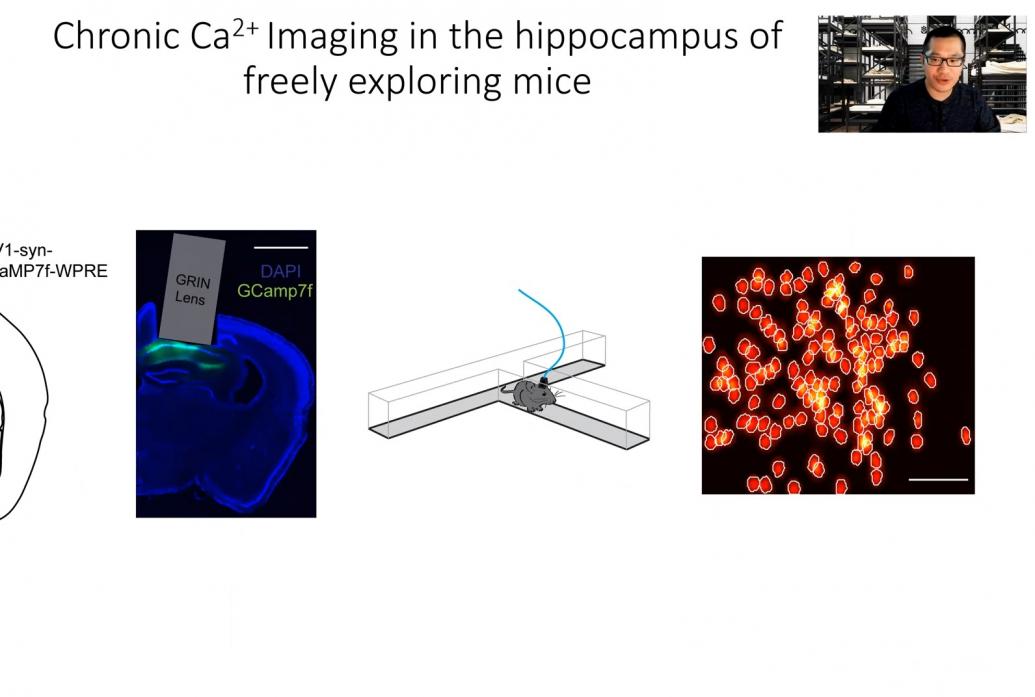
Even though this year’s Society for Neuroscience Annual Meeting was entirely online, it remained an important opportunity for young scientists to share their work with the world. Picower postdocs and graduate students presented numerous research projects at the conference.
“I always encourage my students and postdocs to present their work at SfN and other meetings. Their careers will depend on not just doing science but also communicating science,” said Professor Earl Miller. “I think everyone wishes it was an in-person meeting but nonetheless, it is an opportunity for the students and postdocs to present their work. Besides, there is a lot of cool work going on in the lab. Why should we keep that to ourselves?”
Above: Wilson lab postdoc Wei Guo, employed calcium imaging of neural activity to show that over the course of training, with periods of sleep, more neurons become involved in representing spatial contexts, fine tuning mental maps of places.
Networks & Circuits
Several Miller lab presentations described how higher-level cognition emerges from brain waves coordinating networks of neurons. Postdoc Sayak Bhattacharya’s presentation tracked how waves “travel” around the prefrontal cortex (PFC) during working memory tasks. Others led by former postdoc Andre Bastos showed that brain waves consistently show distinct layer by layer patterns across the cortex’s six-layer structure. Postdoc Alex Major demonstrated suppression of specific PFC cortical layers can differentially affect visual cortical activity.
Meanwhile, graduate student Leo Kozachov presented two projects. In one he combined neural activity measurements and computational models to assess how the brain remains dynamic enough on one hand to account for new sensory input but stable enough to still produce the reliable computations. In the other he and fellow Miller Lab graduate student Adam Eisen show how anesthetic drugs might shut down sensory input by making the brain so stable as to be impervious to new sensory input.
That project was a collaboration with Professor Emery N. Brown who also collaborated with postdoc Elie Adam on a presentation explaining how deep brain stimulation treats Parkinson’s disease by restoring waves of several frequencies in the stimulated area.
Neurons are coordinated not only by brain waves but, of course, by circuits. Tudor Dragoi, former research associate in the lab of Professor Mriganka Sur, presented research showing how marmoset primates use several brain regions to formulate predictions (also see p. 9).
Learning & Memory
Naturally, a function of particular Picower Institute interest is learning and memory.
Graduate student Nhat Le presented his study of how rodents appeared to switch their approach to learning a task, exploring less and relying on their accumulated knowledge of the environment, as they gain more experience in a foraging task.
In the lab of Professor Matt Wilson, postdoc Honi Sanders showed that individual animals vary in the degree to which their brain “remaps” representation of a spatial context when it changes. Wilson lab postdoc Wei Guo, meanwhile, showed that over the course of training, with periods of sleep, more neurons become involved in representing spatial contexts, fine tuning mental maps of places.
Development & Plasticity
Circuits arise when neurons connect via synapses. Several presentations from Professor Troy Littleton’s lab revealed how synapses develop. Research scientist Suresh Jetti tracked structural and molecular differences explaining the fundamentally different activity of two common synapse types. Graduate student Ellen Guss screened for proteins which control assembly and maturation of the synaptic active zone. And graduate student Elizabeth Brija showed how synapses are affected by RNA editing of a key synaptic protein called complexin.
Synapses can come and go, strengthen or weaken, a property called “plasticity.” Members of Professor Mark Bear’s study related developmental diseases. In fragile X autism excessive protein synthesis weakens synapses. Graduate student Max Heinrich’s presentation detailed the search for proteins whose overproduction have particularly deleterious effects. David Stoppel discussed his new paper on treatment resistance to a method of reducing protein overproduction (see p. 3). Postdoc Ming-fai Fong detailed her recent work showing how exploiting plasticity by temporarily anesthetizing a retina resets synapses to treat the vision disorder amblyopia. Postdoc Héctor De Jesús-Cortés, meanwhile, described a vision test the lab can use to assess recovery in lab mice after amblyopia treatment.
Innovations & Inventions
New methods and tools are integral to enabling new discoveries. Brown lab graduate student Indie Garwood, working with MIT Professor Polina Anikeeva, described a fiber-based technology that can deliver chemicals to individual cells to affect their activity. And Wilson Lab postdoc Jie Zhang debuted a new camera that enables vivid imaging of electrical activity in neurons.
Even if remotely, young Picower scientists had a variety of advances to share.

